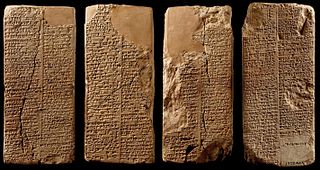Related Research Articles

The Hanging Gardens of Babylon were one of the Seven Wonders of the Ancient World listed by Hellenic culture. They were described as a remarkable feat of engineering with an ascending series of tiered gardens containing a wide variety of trees, shrubs, and vines, resembling a large green mountain constructed of mud bricks. It was said to have been built in the ancient city of Babylon, near present-day Hillah, Babil province, in Iraq. The Hanging Gardens' name is derived from the Greek word κρεμαστός, which has a broader meaning than the modern English word "hanging" and refers to trees being planted on a raised structure such as a terrace.

Ziusudra of Shuruppak is listed in the WB-62 Sumerian King List recension as the last king of Sumer prior to the Great Flood. He is subsequently recorded as the hero of the Eridu Genesis and appears in the writings of Berossus as Xisuthros.
Nabû-nāṣir was the king of Babylon from 747 to 734 BC. He deposed a foreign Chaldean usurper named Nabu-shuma-ishkun, bringing native rule back to Babylon after twenty-three years of Chaldean rule. His reign saw the beginning of a new era characterized by the systematic maintenance of chronologically precise historical records. Both the Babylonian Chronicle and the Ptolemaic Canon begin with his accession to the throne. He was contemporary with the Assyrian kings Aššur-nirarī V and Tiglath-Pileser III, the latter under whom he became a vassal, and the Elamite kings Humban-Tahrah I and Humban-Nikaš I.

Dating creation is the attempt to provide an estimate of the age of Earth or the age of the universe as understood through the creation myths of various religious traditions. Various traditional beliefs hold that the Earth, or the entire universe, was brought into being in a grand creation event by one or more deities. After these cultures develop calendars, a question arises: Precisely how long ago did this creation event happen?

Nabonidus was the last king of the Neo-Babylonian Empire, ruling from 556 BC to the fall of Babylon to the Achaemenian Empire under Cyrus the Great in 539 BC. Nabonidus was the last native ruler of ancient Mesopotamia, the end of his reign marking the end of thousands of years of Sumero-Akkadian states, kingdoms and empires. He was also the last independent king of Babylon. Regarded as one of the most vibrant and individualistic rulers of his time, Nabonidus is characterised by some scholars as an unorthodox religious reformer and as the first archaeologist.

Enūma Eliš, meaning "When on High", is a Babylonian creation myth and the only complete surviving one that can attest to ancient near eastern cosmology. It was recovered by English archaeologist Austen Henry Layard in 1849 in the ruined Library of Ashurbanipal at Nineveh. A form of the myth was first published by English Assyriologist George Smith in 1876; active research and further excavations led to near completion of the texts and improved translation.

Manetho is believed to have been an Egyptian priest from Sebennytos who lived in the Ptolemaic Kingdom in the early third century BC, during the Hellenistic period.
Thallus or Thallos, perhaps a Samaritan, was an early historian who wrote in Koine Greek. He wrote a three-volume history of the Mediterranean world from before the Trojan War to the 167th Olympiad, 112–108 BC, or perhaps to the 217th Olympiad, AD 89-93. Most of his work, like the vast majority of ancient literature, has been lost, although some of his writings were quoted by Sextus Julius Africanus in his History of the World. It is not known when he lived and wrote, but his work is quoted by Theophilus of Antioch, who died around AD 185, and most scholars date Thallus' writings to around 50 AD.

Berossus or Berosus was a Hellenistic-era Babylonian writer, a priest of Bel Marduk and astronomer who wrote in the Koine Greek language, and who was active at the beginning of the 3rd century BC. His original works, including his Babyloniaca, have been lost but fragmentarily survive in some quotations, especially in the writings of the fourth-century Christian writer Eusebius.

Amel-Marduk, also known as Awil-Marduk, or under the biblical rendition of his name, Evil-Merodach, was the third king of the Neo-Babylonian Empire, ruling from 562 BC until his overthrow and murder in 560 BC. He was the successor of Nebuchadnezzar II. On account of the small number of surviving cuneiform sources, little is known of Amel-Marduk's reign and actions as king.
Labashi-Marduk was the fifth and penultimate king of the Neo-Babylonian Empire, ruling in 556 BC. He was the son and successor of Neriglissar. Though classical authors such as Berossus wrote that Labashi-Marduk was just a child when he became king, Babylonian documents indicate that he had been in charge of his own affairs before his rise to the throne, suggesting he was an adult, though possibly still relatively young.

Alulim was a mythological Mesopotamian ruler, regarded as the first king ever to rule. He is known from the Sumerian King List, Ballad of Early Rulers, and other similar sources which invariably place him in Eridu and assign a reign lasting thousands of years to him. The tablet of Old Babylonian period from Ur describing the divine appointment of Alulim by the gods notes that he was chosen among "vast and many people," and appointed by gods for the "shepherdship of the entirety of the many people". Another myth describing his appointment by the gods and incantations treating him as the creator of insects are also known. He is absent from Early Dynastic sources, and he is considered fictional by Assyriologists. His name was preserved in later Greek, Arabic and Persian works.

Nebuchadnezzar I, reigned c. 1121–1100 BC, was the fourth king of the Second Dynasty of Isin and Fourth Dynasty of Babylon. He ruled for 22 years according to the Babylonian King List C, and was the most prominent monarch of this dynasty. He is best known for his victory over Elam and the recovery of the cultic idol of Marduk.

Alexander Heidel (1907–1955) was an Assyriologist and biblical scholar, and a Member of the Research Staff of the Oriental Institute of the University of Chicago.

The Neo-Babylonian Empire or Second Babylonian Empire, historically known as the Chaldean Empire, was the last polity ruled by monarchs native to Mesopotamia. Beginning with the coronation of Nabopolassar as the King of Babylon in 626 BC and being firmly established through the fall of the Assyrian Empire in 612 BC, the Neo-Babylonian Empire was conquered by the Achaemenid Persian Empire in 539 BC, marking the collapse of the Chaldean dynasty less than a century after its founding.

Apkallu or and Abgal are terms found in cuneiform inscriptions that in general mean either "wise" or "sage".
Cyaxares II was a king of the Medes whose reign is described by the Greek historian Xenophon. Some theories have equated this figure with the "Darius the Mede" named in the Book of Daniel. He is not mentioned in the histories of Herodotus or Ctesias, and many scholars doubt that he actually existed. The question of his existence impacts on whether the kingdom of the Medes merged peacefully with that of the Persians in about 537 BC, as narrated by Xenophon, or was subjugated in the rebellion of the Persians against Cyrus' grandfather in 559 BC, a date derived from Herodotus (1.214) and almost universally accepted by current scholarship.

Anu or Anum, originally An, was the divine personification of the sky, king of the gods, and ancestor of many of the deities in ancient Mesopotamian religion. He was regarded as a source of both divine and human kingship, and opens the enumerations of deities in many Mesopotamian texts. At the same time, his role was largely passive, and he was not commonly worshipped. It is sometimes proposed that the Eanna temple located in Uruk originally belonged to him, rather than Inanna, but while he is well attested as one of its divine inhabitants, there is no evidence that the main deity of the temple ever changed, and Inanna was already associated with it in the earliest sources. After it declined, a new theological system developed in the same city under Seleucid rule, resulting in Anu being redefined as an active deity. As a result he was actively worshipped by inhabitants of the city in the final centuries of the history of ancient Mesopotamia.
Lucius Cornelius Alexander Polyhistor was a Greek scholar who was enslaved by the Romans during the Mithridatic War and taken to Rome as a tutor. After his release, he continued to live in Italy as a Roman citizen. He was so productive as a writer that he earned the surname Polyhistor. The majority of his writings are now lost, but the fragments that remain shed valuable light on antiquarian and eastern Mediterranean subjects. Among his works were historical and geographical accounts of nearly all the countries of the ancient world, and the book Upon the Jews which excerpted many works which might otherwise be unknown.

Ancient near eastern (ANE) cosmology refers to the plurality of cosmological beliefs in the Ancient Near East from the 4th millennium BC to the formation of the Macedonian Empire by Alexander the Great in the second half of the 1st millennium BC. This system of cosmology went on to have a profound influence on views in Egyptian cosmology, early Greek cosmology, Jewish cosmology, patristic cosmology, and Islamic cosmology. Until the modern era, variations of ancient near eastern cosmology survived with Hellenistic cosmology as the main competing system.
References
Citations
- ↑ Talon 2001, p. 270–274.
- ↑ Decharneux 2023, p. 116n381.
- ↑ Beaulieu 2006, p. 117–118.
- ↑ Beaulieu 2006, p. 118.
- 1 2 Burstein 1978, p. 8.
- ↑ Beaulieu 2006.
- ↑ Beaulieu 2021.
- ↑ Burstein 1978, p. 4.
- ↑ Beaulieu 2006, p. 119.
- ↑ Burstein 1978, p. 5.
- ↑ George 2021, p. 186.
- ↑ Karst, J. 1911. Eusebius Werke, fünfter Band. Die Chronik aus dem Armenischen übersetzt. Leipzig.
- ↑ Jacoby, F. 1958. Die Fragmente der griechischen Historiker (FGrH), III Geschichte von Staedten und Voelkern, C Autoren über einzelne Laender, I Aegypten–Geten. Leiden.
- ↑ Burstein 1978, p. 6.
- ↑ Beaulieu 2021, p. 147–148.
- ↑ Burstein 1978, p. 6–8.
- ↑ Burstein 1978.
Sources
- Beaulieu, Paul-Alian (2006). Berossus on late Babylonian History. Special Issue of Oriental Studies.
- Beaulieu, Paul-Alain (2021). "Berossus and the Creation Story". Journal of Ancient Near Eastern History. 8 (1–2): 147–170. doi:10.1515/janeh-2020-0012.
- Burstein, Stanley Mayer (1978). The Babyloniaca of Berossus (PDF). Undena Publications.
- Decharneux, Julien (2023). Creation and Contemplation The Cosmology of the Qur'ān and Its Late Antique Background. De Gruyter.
- George, Andrew (2021). "Berossus and Babylonian Cosmogony". In Kelly, Adrian; Metcalf, Christopher (eds.). Gods and Mortals in Early Greek and Near Eastern Mythology. Cambridge University Press. pp. 185–198.
- Talon, Philippe (2001). "Enūma Eliš and the Transmission of Babylonian Cosmology to the West". Melammu. 2: 265–278.